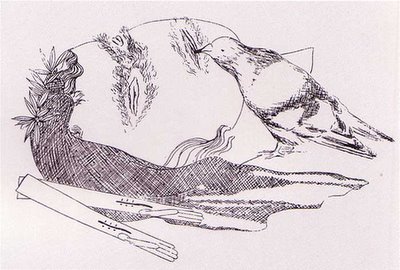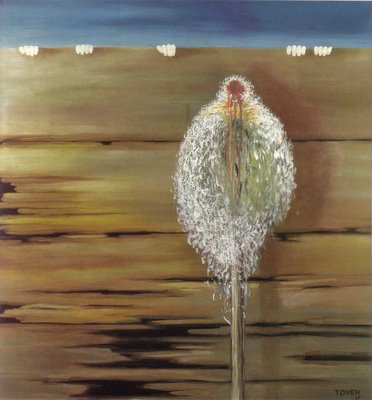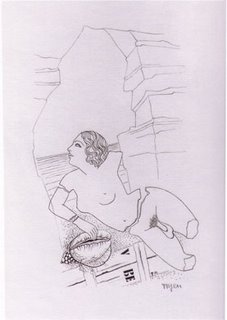Presentation Curiosa
I suppose I should mention the topic of my Fulbright conference presentation. It ended up being titled "Toyen, Gender, and Eroticism in the Czech Context." Originally I had planned to introduce the wider interwar avant-garde group since my research requires that I acquaint myself with practically everyone, but that seemed too broad for a 15-minute talk, so I switched to presenting something closer to my actual dissertation topic. This meant that instead of showing lots of fun caricatures from Rozpravy Aventina,

I was showing images like these:
 Untitled drawing, 1931
Untitled drawing, 1931
 Horror, 1937
Horror, 1937
 The Folding Screen, 1966
The Folding Screen, 1966
 and this lovely 1935 collage by Štyrský.
and this lovely 1935 collage by Štyrský.
They seemed to keep the audience’s attention, at least.
My presentation, though somewhat abridged at the end, seemed well received. The questions, however, surprised me a little. No sooner had I sat down than the woman behind me wanted to know whether I could prove that Toyen wasn’t really a man, because she looked “just like” the man next to her in one of the photos I had shown. (I’m not sure whether she meant the photo of Toyen sitting near Karel Teige and wearing a top hat, the photo of Toyen and Štyrský all dressed up at one of their shows, or the photo of Toyen and Heisler in overalls standing next to crates of paintings.) My interlocutor assured me that many men had successfully masqueraded as women throughout their lives, a fact with which I do not quarrel. (I said I had seen no evidence that Toyen was not female.)
 Having had this question immediately after my talk, I’m not sure why I wasn’t chewing it over all through the next presentation. Perhaps I was too intrigued by Vivian’s discussion of Brožík’s portraiture. In any case, once the floor was open for questions, what should I hear but a person in the back of the room inquiring whether perhaps Toyen was intersexed (in common parlance, a hermaphrodite). Since many more people are born intersexed than is commonly realized, and since this was usually covered up in the past, did I have any medical proof that she was really a woman? After all, she did produce some hermaphroditic imagery!
Having had this question immediately after my talk, I’m not sure why I wasn’t chewing it over all through the next presentation. Perhaps I was too intrigued by Vivian’s discussion of Brožík’s portraiture. In any case, once the floor was open for questions, what should I hear but a person in the back of the room inquiring whether perhaps Toyen was intersexed (in common parlance, a hermaphrodite). Since many more people are born intersexed than is commonly realized, and since this was usually covered up in the past, did I have any medical proof that she was really a woman? After all, she did produce some hermaphroditic imagery!
Well, I would not like to belittle the problem of gendering the intersexed—an issue of which I am well aware and find quite interesting—but I had to reply that despite my lack of direct medical or photographic evidence, I had no reason to believe Toyen was not biologically female (Hana Ripková of the Fulbright office remarked here, with considerable amusement, that she was sure someone or other had photos to answer this question). Toyen was buried in 1980. Had she been a hermaphrodite, the news would have hit the streets the moment her body reached the funeral parlor.
Let me put it this way. With all due respect to transvestites and the intersexed, there is no reason to think that just because Toyen had (mildly) unconventional sexual interests and made art about them, she must therefore really have been either a man or a hermaphrodite. To propose this really harks back to the days when some people tried to pretend that women had no sexual interests at all.
As a biological female who has never been mistaken for either a man or a hermaphrodite, I can assure you that lack of conventionality is not caused by male sex organs.

I was showing images like these:
 Untitled drawing, 1931
Untitled drawing, 1931 Horror, 1937
Horror, 1937 The Folding Screen, 1966
The Folding Screen, 1966 and this lovely 1935 collage by Štyrský.
and this lovely 1935 collage by Štyrský.They seemed to keep the audience’s attention, at least.
My presentation, though somewhat abridged at the end, seemed well received. The questions, however, surprised me a little. No sooner had I sat down than the woman behind me wanted to know whether I could prove that Toyen wasn’t really a man, because she looked “just like” the man next to her in one of the photos I had shown. (I’m not sure whether she meant the photo of Toyen sitting near Karel Teige and wearing a top hat, the photo of Toyen and Štyrský all dressed up at one of their shows, or the photo of Toyen and Heisler in overalls standing next to crates of paintings.) My interlocutor assured me that many men had successfully masqueraded as women throughout their lives, a fact with which I do not quarrel. (I said I had seen no evidence that Toyen was not female.)
 Having had this question immediately after my talk, I’m not sure why I wasn’t chewing it over all through the next presentation. Perhaps I was too intrigued by Vivian’s discussion of Brožík’s portraiture. In any case, once the floor was open for questions, what should I hear but a person in the back of the room inquiring whether perhaps Toyen was intersexed (in common parlance, a hermaphrodite). Since many more people are born intersexed than is commonly realized, and since this was usually covered up in the past, did I have any medical proof that she was really a woman? After all, she did produce some hermaphroditic imagery!
Having had this question immediately after my talk, I’m not sure why I wasn’t chewing it over all through the next presentation. Perhaps I was too intrigued by Vivian’s discussion of Brožík’s portraiture. In any case, once the floor was open for questions, what should I hear but a person in the back of the room inquiring whether perhaps Toyen was intersexed (in common parlance, a hermaphrodite). Since many more people are born intersexed than is commonly realized, and since this was usually covered up in the past, did I have any medical proof that she was really a woman? After all, she did produce some hermaphroditic imagery!Well, I would not like to belittle the problem of gendering the intersexed—an issue of which I am well aware and find quite interesting—but I had to reply that despite my lack of direct medical or photographic evidence, I had no reason to believe Toyen was not biologically female (Hana Ripková of the Fulbright office remarked here, with considerable amusement, that she was sure someone or other had photos to answer this question). Toyen was buried in 1980. Had she been a hermaphrodite, the news would have hit the streets the moment her body reached the funeral parlor.
Let me put it this way. With all due respect to transvestites and the intersexed, there is no reason to think that just because Toyen had (mildly) unconventional sexual interests and made art about them, she must therefore really have been either a man or a hermaphrodite. To propose this really harks back to the days when some people tried to pretend that women had no sexual interests at all.
As a biological female who has never been mistaken for either a man or a hermaphrodite, I can assure you that lack of conventionality is not caused by male sex organs.

2 Comments:
I find it so odd that one of the listener would question whether or not Toyen was a woman. does this mean that in their mind, only men can be creative and talented? I am just puzzled by that. The fact that too few women's works have been publicized and studied is bad enough, but to dispute that they were even female is just absurde to me. Was Georgia O'Keefe a man? I find far more woman in history took a man's name to be able to be published or have their work recognized.
I had the same reaction, especially to the woman who wanted to think Toyen was a man. The person who asked whether Toyen might have been intersexed does work in the area of gender and family planning, so his question probably came more from an interest in minority gender/sexuality issues. His question was perfectly legitimate, yet still brings up the thorny issue of our society's frequent refusal to recognize female creativity and sexuality.
I have to say that while I've given several conference papers and talks on Toyen, I've never before had listeners question her biological gender. I wonder if it was something I said, or just that my previous audiences have been either art historians or Slavic scholars. If I were presenting at a conference on gender, discussion of Toyen's biological gender would not be all that surprising.
Post a Comment
<< Home